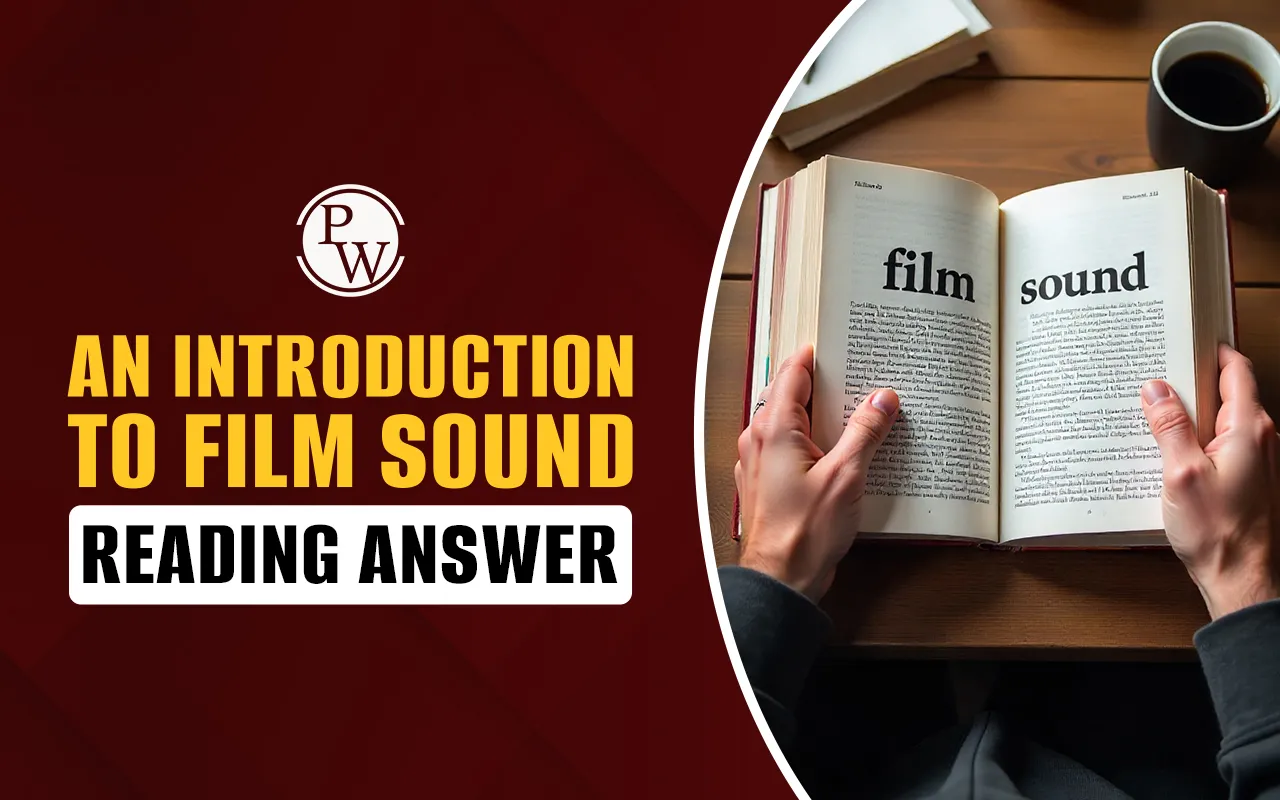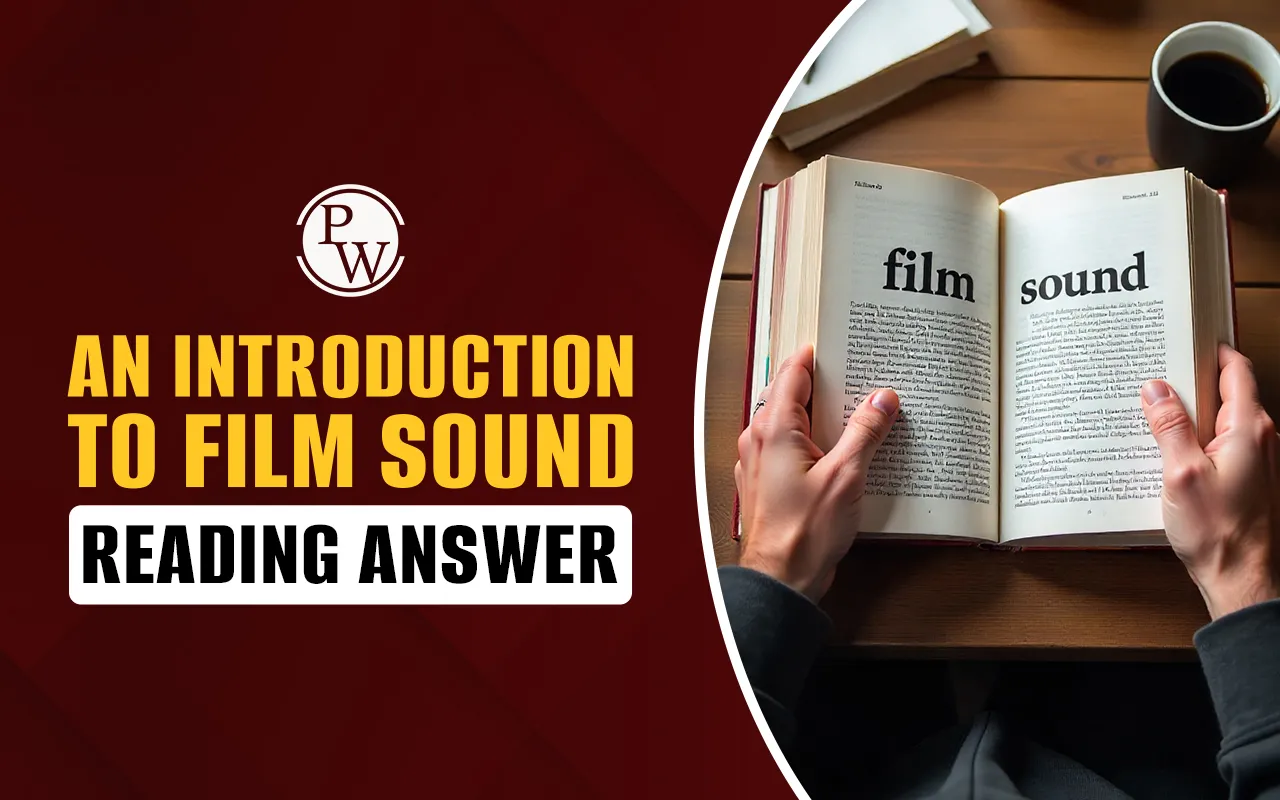
An Introduction to Film Sound Reading answers help learners practice with real exam-style material. The passage explains dialogue, sound effects, and music in films. Many students search for pulling strings to build pyramids, IELTS reading answer key, but working with an introduction to film sound reading passage is equally useful.
It covers an introduction to film sound reading answers and an introduction to film sound reading questions, making it a strong film sound IELTS reading practice. This movie sound IELTS passage also connects with IELTS Reading Topics, IELTS Reading Test Format, IELTS Reading Question Types, and IELTS Reading Band Score.
IELTS An Introduction To Film Sound Reading Passage
An introduction to film sound reading passage explores how dialogue, sound effects, and music shape a movie’s impact. This movie sound IELTS passage is ideal for learners wanting detailed practice. It highlights film sound IELTS reading practice skills while improving comprehension and focus for exam success.
An Introduction To Film Sound Reading Passage
A. Though we might think of film as an essentially visual experience, we really cannot afford to underestimate the importance of film sound. A meaningful soundtrack is often as complicated as the image on the screen, and is ultimately just as much the responsibility of the director. The entire sound track consists of three essential ingredients: the human voice, sound effects and music. These three tracks must be mixed and balanced so as to produce the necessary emphases which in turn create desired effects. Topics that essentially refer to the three previously mentioned tracks are discussed below. They include dialogue, synchronous and asynchronous sound effects, and music.
B. Let us start with dialogue. As is the case with stage drama, dialogue serves to tell the story and expresses feelings and motivations of characters as well. Often with film characterization the audience perceives little or no difference between the character and the actor. Thus, for example, the actor Humphrey Bogart is the character Sam Spade; film personality and life personality seem to merge. Perhaps this is because the very texture of a performer's voice supplies an element of character.
C, When voice textures fit the performer's physiognomy and gestures, a whole and very realistic persona emerges. The viewer sees not an actor working at his craft, but another human being struggling with life. It is interesting to note that how dialogue is used and the very amount of dialogue used varies widely among films. For example, in the highly successful science-fiction film 2001, little dialogue was evident, and most of it was banal and of little intrinsic interest. In this way the film-maker was able to portray what Thomas Sobochack and Vivian Sobochack call, in An Introduction to Film, the 'inadequacy of human responses when compared with the magnificent technology created by man and the visual beauties of the universe'.
The comedy Bringing Up Baby, on the other hand, presents practically non-stop dialogue delivered at breakneck speed. This use of dialogue underscores not only the dizzy quality of the character played by Katherine Hepburn, but also the absurdity of the film itself and thus its humor. The audience is bounced from gag to gag and conversation to conversation; there is no time for audience reflection. The audience is caught up in a whirlwind of activity in simply managing to follow the plot. This film presents pure escapism - largely due to its frenetic dialogue.
D. Synchronous sound effects are those sounds which are synchronized or matched with what is viewed. For example, if the film portrays a character playing the piano, the sounds of the piano are projected. Synchronous sounds contribute to the realism of film and also help to create a particular atmosphere. For example, the 'click' of a door being opened may simply serve to convince the audience that the image portrayed is real, and the audience may only subconsciously note the expected sound. However, if the 'click' of an opening door is part of an ominous action such as a burglary, the sound mixer may call attention to the 'click' with an increase in volume; this helps to engage the audience in a moment of suspense.
Asynchronous sound effects, on the other hand, are not matched with a visible source of the sound on screen. Such sounds are included so as to provide an appropriate emotional nuance, and they may also add to the realism of the film. For example, a film-maker might opt to include the background sound of an ambulance's siren while the foreground sound and image portrays an arguing couple. The asynchronous ambulance siren underscores the psychic injury incurred in the argument; at the same time the noise of the siren adds to the realism of the film by acknowledging the film's city setting.
E. We are probably all familiar with background music in films, which has become so ubiquitous as to be noticeable in its absence. We are aware that it is used to add emotion and rhythm. Usually not meant to be noticeable, it often provides a tone or an emotional attitude toward the story and /or the characters depicted. In addition, background music often foreshadows a change in mood. For example, dissonant music may be used in film to indicate an approaching (but not yet visible) menace or disaster. Background music may aid viewer understanding by linking scenes. For example, a particular musical theme associated with an individual character or situation may be repeated at various points in a film in order to remind the audience of salient motifs or ideas.
F. Film sound comprises conventions and innovations. We have come to expect an acceleration of music during car chases and creaky doors in horror films. Yet, it is important to note as well that sound is often brilliantly conceived. The effects of sound are often largely subtle and are often noted by only our subconscious minds. We need to foster an awareness of film sound as well as film space so as to truly appreciate an art form that sprang to life during the twentieth century - the modern film.
IELTS An Introduction To Film Sound Reading Questions
An introduction to film sound reading questions tests how well you understand the role of sound in films. Practicing with this movie sound IELTS passage helps develop scanning and skimming skills. It is a valuable film sound IELTS reading practice resource for handling various IELTS reading question types.
| IELTS An Introduction To Film Sound Reading Questions | |||
| Q.No | Question Type | Question | Options (if applicable) |
| 1 | Multiple Choice | According to the passage, which three elements make up a film soundtrack? | A) Dialogue, camera, lighting B) Dialogue, sound effects, music C) Music, editing, gestures D) Voice, background, costumes |
| 2 | Multiple Choice | What does dialogue in films mainly do? | A) Creates suspense B) Tells the story and shows feelings C) Provides background D) Only adds humor |
| 3 | True/False/Not Given | The passage suggests that a performer’s voice texture helps shape the character. | – |
| 4 | Sentence Completion | In the film 2001, dialogue is described as ______ and of little interest. | – |
| 5 | Multiple Choice | Why does the comedy Bringing Up Baby use fast-paced dialogue? | A) To confuse the audience B) To create humor and energy C) To show sadness D) To explain technology |
| 6 | True/False/Not Given | Synchronous sound effects are not connected to the visual action on screen. | – |
| 7 | Multiple Choice | Which sound might be highlighted to build suspense? | A) The click of a door B) Soft background music C) Birds chirping D) Actors’ costumes |
| 8 | Matching | Match the type of sound with its description: (i) Synchronous sound (ii) Asynchronous sound | A) Linked with visible action B) No visible source, adds mood |
| 9 | True/False/Not Given | An ambulance siren used during an argument scene is an example of asynchronous sound. | – |
| 10 | Sentence Completion | Background music often helps in ______ a change in mood. | – |
| 11 | Multiple Choice | What does a repeated musical theme in films usually do? | A) Confuse the audience B) Remind viewers of key ideas or characters C) Distract from dialogue D) Replace sound effects |
| 12 | True/False/Not Given | Viewers always consciously notice background music in films. | – |
| 13 | Multiple Choice | What does the passage say about film sound conventions? | A) They are always predictable B) They include creaky doors in horror films C) They are never innovative D) They are unrelated to audience expectations |
| 14 | Sentence Completion | The effects of sound are often ______ and may be noticed only by the subconscious mind. | – |
| 15 | True/False/Not Given | The passage concludes that to truly appreciate films, one should focus only on visuals. | – |
IELTS An Introduction To Film Sound Reading Answers
An introduction to film sound reading answers guide provides clarity for students reviewing this text. Working with a movie sound IELTS passage helps in self-evaluation. It also builds confidence in film sound IELTS reading practice by showing correct approaches to matching questions with passages.
| IELTS An Introduction To Film Sound Reading Answers | ||
| Q.No | Answer | Explanation |
| 1 | B) Dialogue, sound effects, music | The passage states that the soundtrack consists of three essential ingredients: the human voice, sound effects, and music. |
| 2 | B) Tells the story and shows feelings | Dialogue serves to tell the story and express feelings/motivations of characters. |
| 3 | True | The passage says “the very texture of a performer’s voice supplies an element of character.” |
| 4 | Banal | In 2001, dialogue was “banal and of little intrinsic interest.” |
| 5 | B) To create humor and energy | The film used fast-paced dialogue to highlight dizzy characters and humor, creating a whirlwind effect. |
| 6 | False | Synchronous sound effects are connected with what is viewed (e.g., piano playing with piano sound). |
| 7 | A) The click of a door | Passage explains the “click” of a door may be amplified to build suspense. |
| 8 | (i) A, (ii) B | Synchronous = linked with visible action; Asynchronous = no visible source, adds mood. |
| 9 | True | An ambulance siren during an argument is the passage’s own example of asynchronous sound. |
| 10 | Foreshadowing | Background music foreshadows a change in mood, e.g., dissonant tones before danger. |
| 11 | B) Remind viewers of key ideas or characters | A repeated theme reminds the audience of motifs or characters. |
| 12 | False | Music is usually “not meant to be noticeable” and often works subconsciously. |
| 13 | B) They include creaky doors in horror films | The passage mentions “acceleration of music in car chases and creaky doors in horror films” as conventions. |
| 14 | Subtle | Sound effects are often “subtle” and noticed only subconsciously. |
| 15 | False | The conclusion stresses awareness of both film sound and film space, not visuals alone. |
Guidance to PW IELTS Prep
IELTS Online Courses is a great initiative Physics Wallah took to help IELTS aspirants better prepare for the exam. Follow our below pages to learn more about the IELTS exam.| IELTS Reading Band Score | IELTS Listening Band Score |
| IELTS Speaking Band Score | IELTS Writing Band Score |
IELTS An Introduction To Film Sound Reading Answers FAQs
What is the main focus of An Introduction to Film Sound Reading Passage?
What type of IELTS passage is this?
Which skills are tested in An Introduction to Film Sound Reading Questions?
Where can I find An Introduction to Film Sound Reading Answers?
Is this passage useful for IELTS exam preparation?












